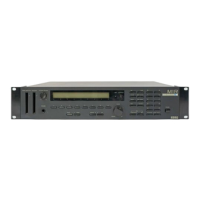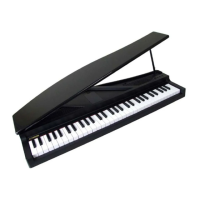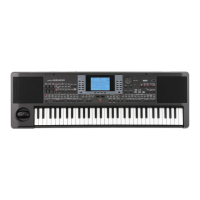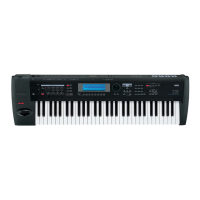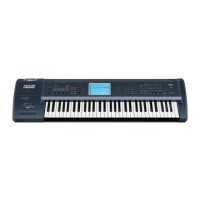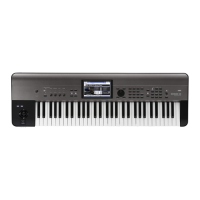Overview The structure of the KARMA function
165
Quick Start
Introduction
SetupProgram
Combination
Sequencer
SamplingGlobalMediaEffectKARMA
Drum Track
Other
Appendices
* RTC Model
All of the preset GEs have an internally-specified RTC
Model. The RTC Model is a certain standardization of
the more than two hundred internal parameters of the
GE, based on the type and purpose of that GE.
GEs for which the same RTC Model has been specified
will (by default) have the same parameters assigned as
their GE realtime parameters. This means that even if
you’re switching through various GEs that have the
same RTC Model, you will be able to control them in a
uniform manner and make valid comparisons between
them, since their default state will be the same. Of
course, you are free to edit the GE realtime parameters.
In the pre-loaded programs and combinations, the
KARMA sliders and KARMA switches are assigned in
a uniform manner depending on the RTC Model for
the GE used by each module. For example if a KARMA
module used by a program or combination uses a GE
of the Drum/Percussion category, the KARMA sliders
and KARMA switches will be assigned so that Slider 1
controls the swing and Slider 2 controls the pattern
variation. Of course, you are also free to edit the
KARMA sliders and KARMA switches assignments.
Each GE is assigned one of the following RTC Models.
• DP1 - Drum/Perc
• BL1 - Bass/Lead
• DM1 - Drum Melodic
• GV1 - Gated Vel/Pattern
• GC1 - Gated CCs
• CL1 - Comp/Lead
• WS1 - WaveSeq 1
• WS2 - WaveSeq 2
• EG1 - Dual Env Gen
• LF1 - Dual LFOs
• MR1 - Melodic Repeat
• MB1 - Mel Rpt/Bend
• RB1 - Real-Time Bend
• Custom - a few GEs may require special RTC
setups, outside of the normal RTC Models. In this
case, the assignment of RTC Controls is left up to
the sound designer of the specific Program or
Combination.
An example is 2073: VJS Motion. If you load this GE, it
clears all RTC Model assignments (when the GE Load
Options are set to the default setting). With such GEs,
it’s generally best to copy the Module from an existing
Program, so that you have an example of how to map
the controls.
* Auto RTC Setup
This is a convenient function that automatically makes
KARMA sliders and KARMA switches assignments
according to the RTC Model setting of a GE. Use the
Load GE Options dialog box to make these settings
automatically. Here you can choose whether you want
KARMA controller assignments to be made
automatically when you use the GE Select parameter
to select a GE. If you’ve chosen Auto RTC Setup in this
dialog box, the assignments will be made
automatically each time you change the GE. This
means that regardless of the type of GE that’s selected,
you will immediately be able to use the standard
KARMA CONTROL assignments. (See PG page 4)
KARMA module parameters
These are the parameters that control the phrases and
patterns generated by a KARMA module.
You can set these parameters independently for each
KARMA module. These parameters include the GE
selection, MIDI input/output channel, key zone, MIDI
filtering, and triggering.
GE RTP (GE Real-Time Parameters)
Perf RTP (Perf Real-Time Parameters)
These are the parameters that you can control via the
KARMA sliders or KARMA switches.
If GE realtime parameters (GE RTP) and KARMA
module parameters (Perf RTP) are assigned to the
KARMA sliders and KARMA switches, you’ll be able
to control them in realtime to modify the phrase or
pattern while you play.
Dynamic MIDI
Dynamic MIDI is a function that uses the M3’s
controllers or MIDI control messages to control specific
functions of the KARMA function.
For example, this enables you to use the joystick to
play strummed guitar chords, use a foot switch to
control the Run/Mute status of a KARMA module, or
use the damper pedal to latch a KARMA module.
You’ll be able to control them in realtime while you
play.
